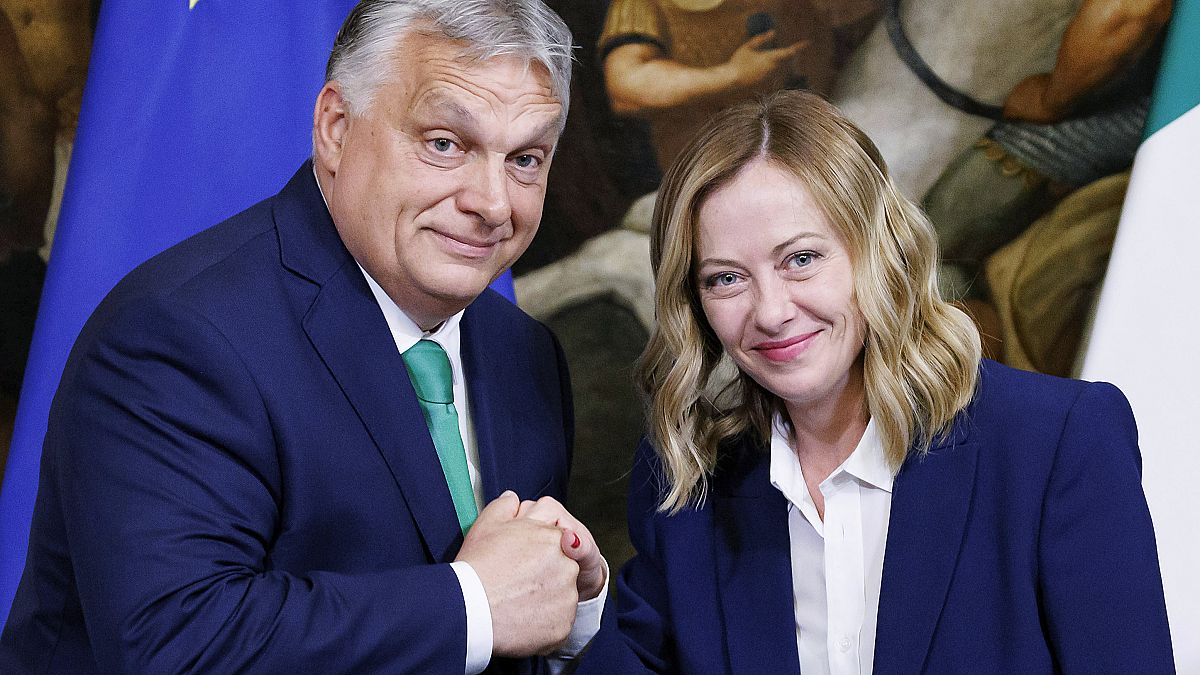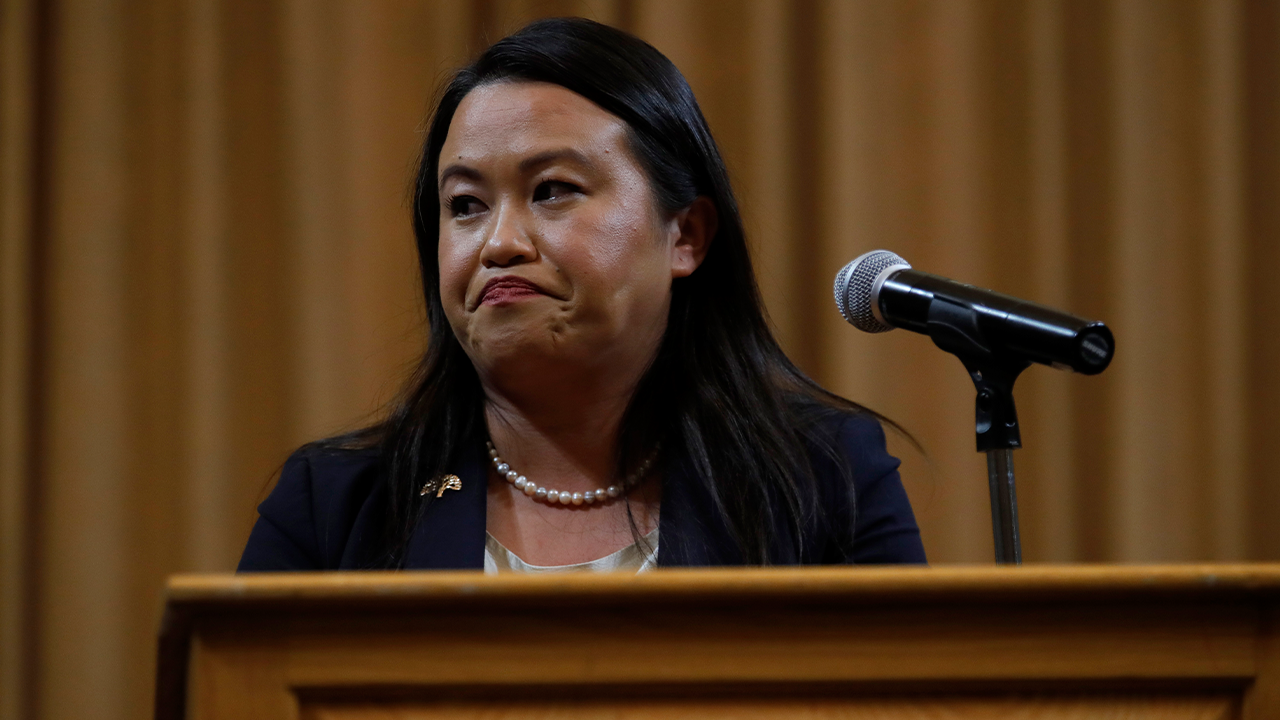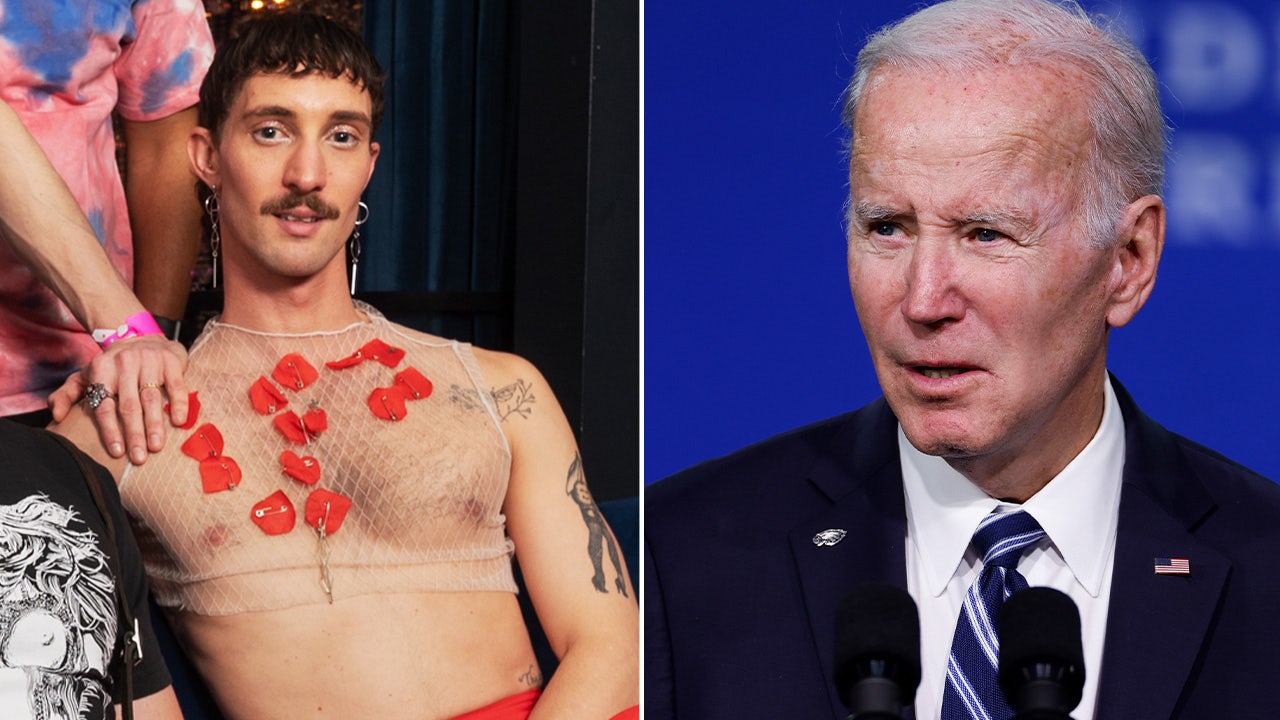World
Rewetting peatland is good for the climate. Europe is very slow at it
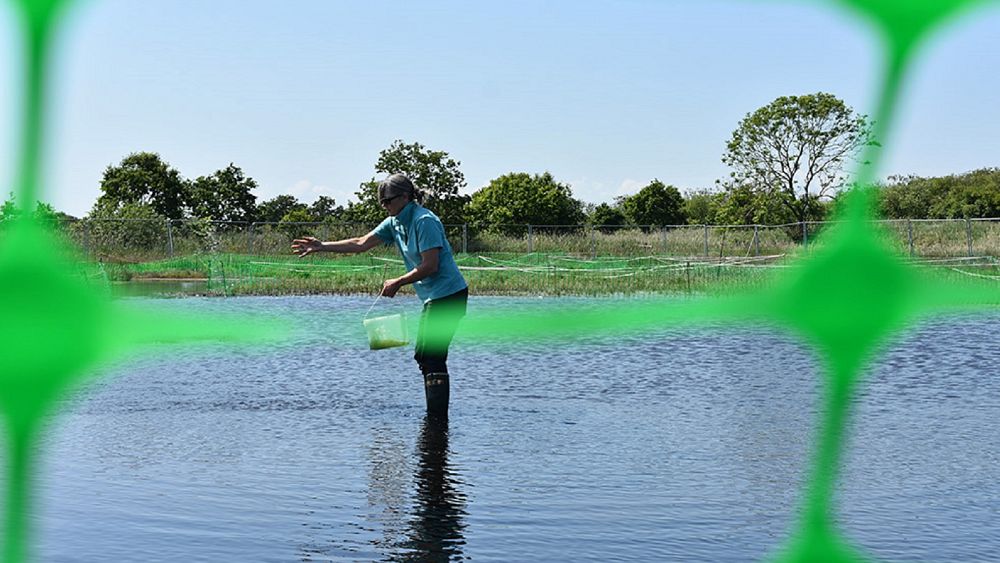
Rewetting drained land could help in the fight against climate change but the EU’s agricultural subsidies scheme currently favours the use of drained land.
Dutch farmer Aldert van Weeran plucked a thick stalk of bright green sweet grass from his flooded field. For most farmers in Europe, a field saturated with water at surface level would spell disaster, but Van Weeran was delighted with the mud.
In 2020, he rewet 1.5 hectares of drained peatland situated just outside Amsterdam and started a type of wetland farming known as paludiculture. Van Weeran’s crop, a species of Typha, has flourished.
But as experts around the world call to rewet drained wetlands to absorb greenhouse gases, restore biodiversity and provide ecosystem services, a serious question looms: What happens to millions of other farmers who make their living from drained land?
“Paludiculture is the solution to multiple problems,” said van Weeran, who sells the Typha to a building company for insulation materials as well as the carbon credits his expanding farm produces.
Van Weeran is part of a small, experimental but growing movement of European farmers, researchers and business owners from Estonia to Ireland working to turn paludiculture into a feasible alternative to farming drained wetlands, but they face a dense web of regulatory and cultural obstacles.
Why wetlands matter in the fight against climate change
A February 2023 study in the journal Nature estimated that, globally, 21% of inland wetlands have been lost in the last 300 years, predominantly due to drainage for agriculture, with the biggest losses in China, the United States and Europe. A team from the University of Exeter found that 40 billion tons of carbon have been released from drained wetlands in the Northern Hemisphere since 1750.
Portions of Europe’s bogs and fens have been drained for a thousand years to harvest carbon-rich peat – plant material that has partly decayed underwater for millennia – for fuel. But research has shown that in the 20th century, agricultural mechanisation, government subsidies and a growing population increased the speed of Europe’s peatland drainage dramatically.
The Nature report revealed that the United Kingdom has drained about 75% of its wetlands while The Netherlands has lost more than 70% for farmland and development. Sweden, Finland and Estonia have lost more than 45% of their wetlands to forestry alone.
“Presently, drained peatlands constitute about 10% of Estonia’s total emissions,” Jüri-Ott Salm, wetlands programme coordinator with the Estonian Fund for Nature, told Euronews.
“If we would like to achieve carbon neutrality, to decrease these emissions, then one way ahead is paludiculture,” he said, though added, “the main challenge is to turn drained peatlands back to wetlands and to manage them with paludiculture.”
Draining peatland releases carbon dioxide and nitrogen oxides, gases that contribute to climate change. And in a summer when Europe has been plagued alternately with severe droughts and devastating flooding, advocates of rewetting these vast regions say there is ample reason.
Wetlands control flooding, filter toxic chemicals from water, aid groundwater retention, boost drought resilience, enable biodiversity and habitat expansion, and act as enormous carbon sinks.
But researchers are still met with resistance from farmers who have cultivated drained peatland for generations.
“We do need more research on the emotional psychological aspects of this, especially in those areas where the farmland was in the family for a very long time,” said Anke Nordt, a peatlands researcher at the Greifswald Mire Centre in northeastern Germany.
“[Farmers] say, ‘I would do it, but I can’t rewet because my ancestors put so much effort in draining it,’” she said.
More often, though, experts from across Europe told Euronews, the strongest objections are far more practical.
EU agriculture subsidies benefiting drained land
Until this year, the EU’s common agricultural policy (CAP) excluded from subsidy payments paludiculture crops such as Typha, peat moss, reed, and cattail while heavily subsidising livestock and arable farming on drained peatland for decades.
The new CAP, which took effect in January, includes paludiculture but left implementation of payment schemes to member states, creating uncertainty and a potential patchwork of regulation, while still incentivising agriculture on drained land.
Early adopters of paludiculture say those incentives must end for wetland farming to take root.
“We have to look for the polluters pay principle,” said Jens-Uwe Holthuis, project manager at Sphagnumfarm Barver, a peat moss, or sphagnum, paludiculture demonstration site in Lower Saxony, Germany.
Holthuis explained that when farmers drain land and release greenhouse gases, it is the public who pays the price of climate impacts.
“Farmers who are draining their land have to pay or have to lose the subsidies they are getting for draining the land,” Holthuis said.
Even if direct payments to those growers ended, there are still major hurdles to overcome. Longstanding land use laws, individual land rights, upfront costs and developing markets for paludiculture products will all need careful attention, researchers say. In some countries, water rights are particularly contentious.
In Britain under recent reforms, the Environment Agency has rescinded some water abstraction licenses of farmers working on drained land.
“We need a different system of water judgement for peatlands,” said Andrea Kelly, an environmental policy adviser with the Broads Authority in East Anglia, England. Kelly manages several wetlands restoration projects including a paludiculture site.
“The peat can’t be moved. The water can. So if we want to deliver net-zero through peatlands … if our farming, as a sector, want to get hold of that [opportunity] then they need to be enabled, and the only way is to deliver the water,” she told Euronews.
Governments start rewetting programmes
As enthusiastic as paludiculture pioneers are, all agree that for farmers to achieve a just transition into wetland cultivation, market economics must also scale up considerably. The avant-garde remains optimistic, if pragmatic, and points to multiple industries that are already incorporating paludiculture crops in manufacturing.
Typha is used in building materials and insulation, paper, food in high-end restaurants, and in animal feed. The most well-known product, reed, has been used in traditional thatched roofs for centuries.
Clothing maker saltyco uses cattail fibers in its insulated cloth, and sphagnum supplier BeadaMoss is developing a peat moss alternative to extracting raw peat, which currently underpins the multibillion euro global horticulture industry as a planting medium.
Researchers say that sales revenue combined with appropriate agricultural subsidies, ecosystem services and carbon sequestration payments could provide a livelihood at least as stable as many farmers on drained lands have now, but without the cost of feed, fertilizer, or environmental damage.
With net-zero commitments in mind, individual governments have begun to take notice.
Germany has invested up to €150 million in two 10-year paludiculture projects comprising at least 10 sites. England last year earmarked £5 million (€5.85 million) for paludiculture grants and awarded 12 projects funding in June.
For Aldert van Weeran, approaching his second Typha harvest, the equation is simple.
In the end, he said, ecologically “the math is about destroying, or rebuilding.”

World
WikiLeaks founder Julian Assange stops in Bangkok on his way to a US court and later freedom
BANGKOK (AP) — A plane believed to be carrying Julian Assange landed Tuesday in Bangkok, as the WikiLeak founder was on his way to enter a plea deal with the U.S. government that will free him and resolve the legal case that spanned years and continents over the publication of a trove of classified documents.
Chartered flight VJT199 landed after noon at Don Mueang International Airport, north of the Thai capital. It was unclear if the plane was only refueling or how Assange will continue traveling to Saipan, the capital of the Northern Mariana Islands, a U.S. commonwealth in the Western Pacific, where he will appear in court Wednesday morning local time.
Protesters hold placards in support of WikiLeaks founder Julian Assange outside the High Court in London, Monday, May 20, 2024. (AP Photo/Kin Cheung, File)
He’s expected to plead guilty to an Espionage Act charge of conspiring to unlawfully obtain and disseminate classified national defense information, according to the U.S. Justice Department in a letter filed in court.
Assange is expected to return to his home country of Australia after his plea and sentencing. The hearing is taking place in Saipan because of Assange’s opposition to traveling to the continental U.S. and the court’s proximity to Australia, prosecutors said.
The guilty plea, which must be approved by a judge, brings an abrupt conclusion to a criminal case of international intrigue and to the U.S. government’s years-long pursuit of a publisher whose hugely popular secret-sharing website made him a cause célèbre among many press freedom advocates who said he acted as a journalist to expose U.S. military wrongdoing. Investigators, by contrast, have repeatedly asserted that his actions broke laws meant to protect sensitive information and put the country’s national security at risk.
Attorneys for Assange haven’t responded to requests for comment.
In a statement posted on X, WikiLeaks said Assange boarded a plane and departed Monday after leaving the British prison where he has spent the last five years. WikiLeaks applauded the announcement of the deal, saying it was grateful for “all who stood by us, fought for us, and remained utterly committed in the fight for his freedom.”
“WikiLeaks published groundbreaking stories of government corruption and human rights abuses, holding the powerful accountable for their actions. As editor-in-chief, Julian paid severely for these principles, and for the people’s right to know,” WikiLeaks said.
Australian Prime Minister Anthony Albanese, who has been lobbying for the United States to end its prosecution of Assange, told Parliament that an Australian envoy had flown with Assange from London.
“Regardless of the views that people have about Mr. Assange’s activities, the case has dragged on for too long. There’s nothing to be gained by his continued incarceration and we want him brought home to Australia,” Albanese added.
The deal ensures Assange will admit guilt while also sparing him from additional prison time. He had spent years hiding in the Ecuadorian Embassy in London after Swedish authorities sought his arrest on rape allegations before being locked up in the United Kingdom.
Assange is expected to be sentenced to the five years he has already spent in the British prison while fighting extradition to the U.S. to face charges, a process that has played out in a series of hearings in London. Last month, he won the right to appeal an extradition order after his lawyers argued that the U.S. government provided “blatantly inadequate” assurances that he would have the same free speech protections as an American citizen if extradited from Britain.
Buildings are reflected in the window as WikiLeaks founder Julian Assange is taken from court, where he appeared on charges, Wednesday May 1, 2019 of jumping British bail seven years ago, in London. (AP Photo/Matt Dunham, File)
Assange has been heralded by many around the world as a hero who brought to light military wrongdoing in Iraq and Afghanistan. Among the files published by WikiLeaks was a video of a 2007 Apache helicopter attack by American forces in Baghdad that killed 11 people, including two Reuters journalists.
But his reputation was also tarnished by rape allegations, which he has denied.
The Justice Department’s indictment unsealed in 2019 accused Assange of encouraging and helping U.S. Army intelligence analyst Chelsea Manning steal diplomatic cables and military files that WikiLeaks published in 2010. Prosecutors had accused Assange of damaging national security by publishing documents that harmed the U.S. and its allies and aided its adversaries.
Prosecutors said in a charging document filed in connection with the plea agreement that Assange conspired with Manning to receive and obtain documents, notes and other writings related to the national defense and to “willfully communicate” those records. The document takes care to note that Assange was “not a United States citizen, did not possess a U.S. security clearance, and did not have authorization to possess, access, or control documents, writings, or notes relating to the national defense of the United States, including classified information.”
The case was lambasted by press advocates and Assange supporters. Federal prosecutors defended it as targeting conduct that went way beyond that of a journalist gathering information, amounting to an attempt to solicit, steal and indiscriminately publish classified government documents.
The plea agreement comes months after President Joe Biden said he was considering a request from Australia to drop the U.S. push to prosecute Assange. The White House was not involved in the decision to resolve Assange’s case, according to a White House official who was not authorized to speak publicly about the case and spoke to The Associated Press on condition of anonymity.
Assange made headlines in 2016 after his website published Democratic emails that prosecutors say were stolen by Russian intelligence operatives. He was never charged in special counsel Robert Mueller’s Russia investigation, but the inquiry laid bare in stark detail the role that the hacking operation played in interfering in that year’s election on behalf of then-Republican candidate Donald Trump.
During the Obama administration, Justice Department officials mulled charges for Assange but were unsure a case would hold up in court and were concerned it could be hard to justify prosecuting him for acts similar to those of a conventional journalist.
The posture changed in the Trump administration, however, with former Attorney General Jeff Sessions in 2017 calling Assange’s arrest a priority.
Assange’s family and supporters have said his physical and mental health have suffered during more than a decade of legal battles.
Assange took refuge in the Ecuadorian Embassy in London in 2012 and was granted political asylum after courts in England ruled he should be extradited to Sweden as part of a rape investigation in the Scandinavian country. He was arrested by British police after Ecuador’s government withdrew his asylum status in 2019 and then jailed for skipping bail when he first took shelter inside the embassy.
Although Sweden eventually dropped its sex crimes investigation because so much time had elapsed, Assange had remained in London’s high-security Belmarsh Prison during the extradition battle with the U.S.
___
Tucker reported from Fort Pierce, Florida and Durkin Richer from Washington. Associated Press writer Colleen Long in Washington contributed to this report.
World
Iran's young voters navigate presidential race shaped by 2022 clashes

- For young voters in Iran, the memories of the 2022 clashes against rulers have shaped the upcoming presidential race.
- All six candidates have targeted youth voters through social media, recognizing their role in Iran’s political future.
- The memory of the 2022 protests continues to influence Iranian youth, shaping their outlook on governance and political participation.
Atousa joined angry protests against Iran’s rulers in 2022 that loyalists like Reza helped crush. Two years on, the two young Iranians’ political views remain at odds, reflecting a rift that will shape the outcome of presidential elections this week.
Now 22, Atousa says she will abstain from voting in Friday’s ballot to choose a successor to Ebrahim Raisi after his death in a helicopter crash, regarding the exercise with derision.
But Reza, 26, a religiously devout member of the hardline Basij militia, intends to vote, a contrasting view of the worth of the election that underscores the division in Iran between supporters and opponents of the 45-year-old Islamic Republic.
TOP SECRET IRANIAN DRONE SITE USED BY IRGC, TERROR PROXIES EXPOSED BY OPPOSITION GROUP
All six candidates – five hardliners and a low-key moderate approved by a hardline watchdog body – have been wooing youthful voters in speeches and campaign messages, using social media to reach the 60% of the 85 million population aged under 30.
People light a fire during a protest over the death of Mahsa Amini, a woman who died after being arrested by the Islamic republic’s “morality police”, in Tehran, Iran, on Sept. 21, 2022. (West Asia News Agency)
“This election, like all elections in Iran, is a circus. Why should I vote when I want the regime to be toppled?,” Atousa told Reuters. She declined to be identified by her full name for security reasons.
“Even if it was a free and fair election and if all candidates could enter the race, the president in Iran has no power,” she said.
The hashtag #ElectionCircus has been widely posted on social media platform X by Iranians in the past few weeks, while some Iranians at home and abroad have called for an election boycott.
RADICAL IRANIAN PROVINCE HIT BY ISRAEL HIGHLIGHTS REGIME’S WEAKNESSES
Under Iran’s clerical system, the elected president runs the government day-to-day but his powers are circumscribed by those of the hardline supreme leader Ayatollah Ali Khamenei, who has the last word on top issues such as nuclear and foreign policy.
‘RELIGIOUS DUTY TO VOTE’
Like many women and young Iranians, Atousa joined protests in 2022 sparked by the death of a young Kurdish woman, Mahsa Amini, in police custody, following her arrest for allegedly violating Iran’s mandatory Islamic dress code.
The unrest spiraled into the biggest show of opposition to Iran’s clerical rulers in years.
Atousa, then a student, was arrested during the protests and her dream of becoming an architect was shattered when she was expelled from university as a punishment for participating in the demonstrations.
The Basij, a plain-clothes arm of the elite Revolutionary Guards, deployed alongside uniformed security during the 2022 unrest and helped suppress demonstrations with deadly force.
Over 500 people including 71 minors were killed in the protests, hundreds injured and thousands arrested in unrest that was eventually crushed by security forces, rights groups said.
Iran carried out seven executions linked to the unrest. Authorities have not given any official estimated death toll, but said dozens of security forces were killed in “riots”.
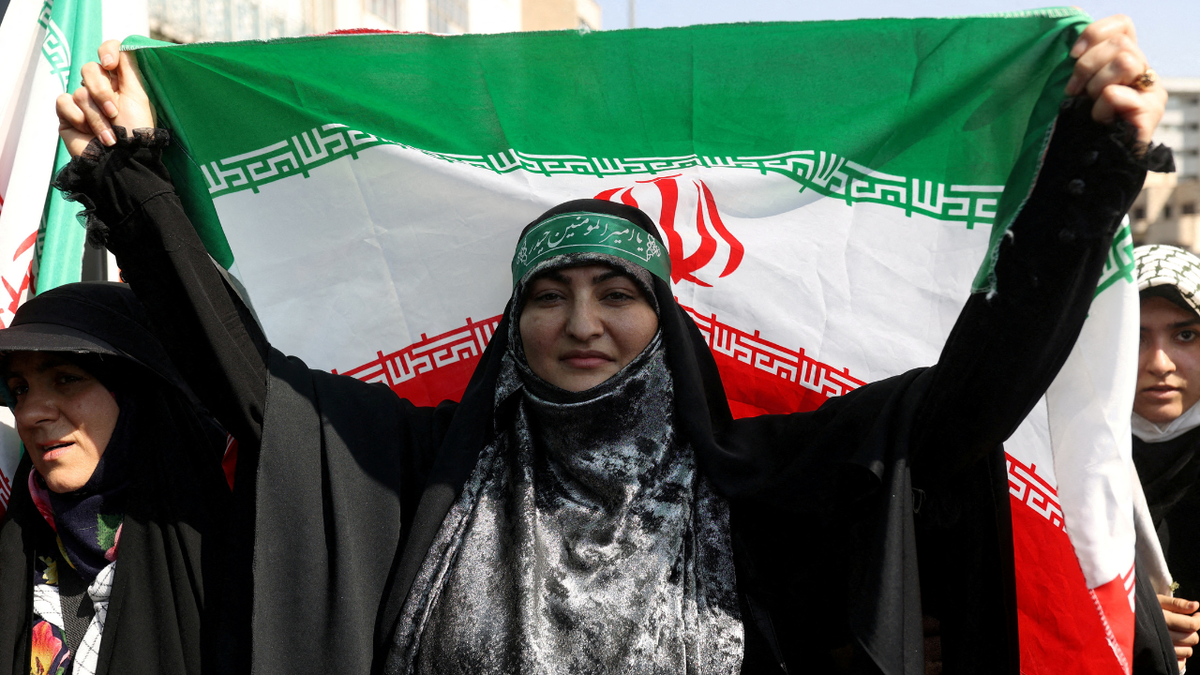
An Iranian pro-government woman holds the Iranian flag during a rally against the recent protest gatherings in Iran, after the Friday prayer ceremony in Tehran, Iran, on Sept. 23, 2022. (Majid Asgaripour/West Asia News Agency)
“I will sacrifice my life for the leader and the Islamic Republic. It is my religious duty to vote. My participation will strengthen the Nezam (system),” said Reza, from the low-income Nazi Abad district in south Tehran.
Reza said he will support a hardline candidate who champions Khamenei’s “resistance economy”, a phrase meaning economic self-sufficiency, strengthening trade ties with regional neighbors and improving economic interaction with China and Russia.
The economy is beset by mismanagement, state corruption and sanctions reimposed since 2018 after the U.S. ditched Tehran’s 2015 nuclear pact with six world powers.
Reza and Atousa, both born after the 1979 Islamic Revolution, have regrets about the 2022 demonstrations, albeit for different reasons.
Reza blames the protests for bringing mounting pressure on Iran from Western countries, which imposed sanctions on Iranian security forces and officials for alleged human rights abuses. Iran accused Western powers of fomenting the unrest.
“I wish the protests had not taken place … our enemies used it as a pretext to mount pressure on our country,” he said.
Atousa looks back on that period with sadness.
“I was hopeful,” she said. “I thought finally the change will come and I will be able to live a life with no suppression in a free country … I paid a heavy price, but the regime is still here.”
World
The Take: Will France’s election gamble pay off for Macron – or backfire?

PodcastPodcast, The Take
French President Emmanuel Macron has called a snap election. Could he be setting himself up for defeat?
Following a European Union election victory for France’s far-right, French President Emmanuel Macron decided to dissolve parliament. Now, France is facing a snap election and voting begins on June 30. With the far-right National Rally projected to win, what will the future of France look like?
In this episode:
- Tristan Redman (@TristanAJE), Al Jazeera senior producer and host of the award-winning investigative podcast Ghost Story
Episode credits:
This episode was produced by David Enders, and Duha Mosaad, with Amy Walters, Chloe K Li, Mohammed Zain Shafi Khan, Manahil Naveed and our host, Natasha Del Toro, in for Malika Bilal.
Our sound designer is Alex Roldan. Our lead of audience development and engagement is Aya Elmileik. Munera Al Dosari and Adam Abou-Gad are our engagement producers.
Alexandra Locke is The Take’s executive producer and Ney Alvarez is Al Jazeera’s head of audio.
Connect with us:
@AJEPodcasts on Twitter, Instagram, Facebook, Threads and YouTube
-

 World1 week ago
World1 week agoSwitzerland's massive security effort at the Ukraine peace conference
-

 News1 week ago
News1 week agoJoe Biden, Barack Obama And Jimmy Kimmel Warn Of Another Donald Trump Term; Star-Filled L.A. Fundraiser Expected To Raise At Least $30 Million — Update
-

 News1 week ago
News1 week agoIt's easy to believe young voters could back Trump at young conservative conference
-

 World1 week ago
World1 week agoSwiss summit demands 'territorial integrity' of Ukraine
-

 World1 week ago
World1 week agoProtesters in Brussels march against right-wing ideology
-

 World1 week ago
World1 week agoRussia-Ukraine war: List of key events, day 842
-

 Politics1 week ago
Politics1 week agoBiden looks to capitalize on star-studded Hollywood fundraiser after Trump's massive cash haul in blue state
-

 Politics1 week ago
Politics1 week agoJudge rules Missouri abortion ban did not aim to impose lawmakers' religious views on others
